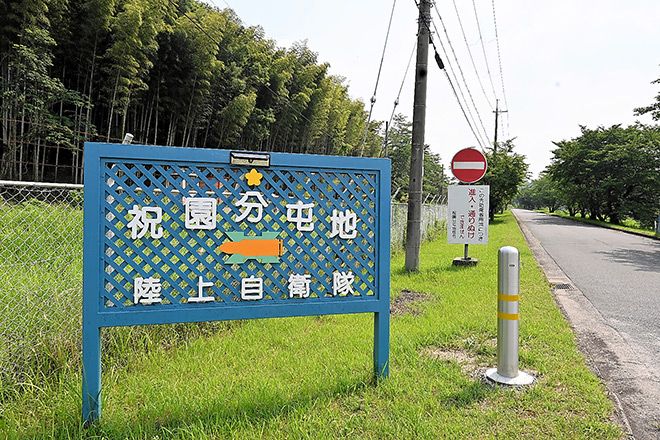Residents of a science city close to Kyoto that is known for its many cultural and research facilities are up in arms over a plan by the Defense Ministry to build more ammunition storage sites at a Ground Self-Defense Force base there.
The ministry will begin the expansion program at Vice Camp Hosono in Seika, a town in Keihanna Science City, in August.
Plans call for 14 ammunition storage buildings to be built under the Defense Buildup Program established by the government in late 2022. The sites will have the largest storage capacity in Japan. The type of ammunition to be stored has not been disclosed, adding to the concerns among residents.
The ministry plans to construct 70 or so additional ammunition storage facilities across Japan by fiscal 2027.
The Defense Buildup Program allocates 61.6 billion yen ($416 million) for new storages sites from fiscal 2023 through fiscal 2025, with about half, or 30.4 billion yen, designated for building storage facilities at Vice Camp Hosono.
On July 1, seven senior officials from the ministry’s Kinki-Chubu Defense Bureau briefed the Seika town assembly on the project that will begin with earthwork in August.
The ministry expects the eight buildings will be completed by the end of fiscal 2027. Construction of the remaining six facilities will follow as soon as the site is ready.
With a growing population of 250,000-plus, Keihanna Science City compasses eight cities and towns in Kyoto, Osaka and Nara Prefectures over an area of about 15,000 hectares. It is home to more than 150 public and private research facilities and seven universities as well as many residential areas.
The government included possessing counterstrike capabilities in security-related documents it arbitrarily revised and then released in late 2022.
With China’s military buildup in mind, the government deployed troops to the furthermost Nansei chain of islands close to Taiwan to operate missile batteries.
During the briefing, assembly members raised numerous issues. They wanted to know whether long-range missiles for attacking enemy bases would be stored there and what safety measures would be taken to protect residents from accidents, such as an ammunition dump exploding.
The ministry officials refused to divulge specifics for fear of compromising the SDF’s capabilities there. However, they pledge to “secure a sufficient safety radius” based on the Explosives Control Law and related legislation.
A briefing on the construction project was also held on the evening of July 22 for Kyotanabe city residents, and about 90 people attended.
Like those in the Seika town assembly, the residents clamored for details. Many wondered how such a project could be approved “without knowing what will be stored in our backyard.” Others pressed for more explanation about storing missiles with “enormous destructive power” and the consequences of a serious accident.
Most questions centered on the type of ammunition to be stored, but the ministry stayed mum. Similar briefing sessions were held for Seika town residents on July 24 and 26.
Vice Camp Hosono is surrounded by residential areas and research institutions.
Area residents established a network in March last year to demand clarification on the types of ammunition to be stored, along with other issues. The network collected more than 10,000 signatures and submitted the petition to the Defense Ministry.
After listening to the explanation from the ministry, Mayumi Kureha, co-representative of the resident network, said, “It heightened our fears that long-range missiles will be stored.”
TOMAHAWK POSSIBITLITY
Journalist Yujin Fuse, an expert in the national security field, noted that Vice Camp Hosono sprawls over 466 hectares, roughly the size of 100 Tokyo Domes.
“In addition to its size, the fact that the facility is surrounded by mountains, making it invisible to everybody, increases its strategic value as a military site,” he said.
In the event of a Taiwan contingency, troops, weapons and ammunition from the main islands of the Japanese archipelago would be sent to the Nansei islands.
A maritime transport unit centered on the GSDF was introduced in April to support this operation.
The Maritime SDF bases in Kure in Hiroshima Prefecture and Hanshin in Kobe will serve as key hubs for the new unit.
“Vice Camp Hosono is just about an hour away from the Hanshin base via expressway. Its accessibility is also a major advantage,” Fuse said.
U.S.-made Tomahawk cruise missiles, which have a range of 1,600 kilometers or more and are intended for counterstrike purposes, are expected to be deployed on the MSDF’s Aegis warships.
Vice Camp Hosono will be jointly operated with the MSDF in the future. Given that there is a base for Aegis warships in the city of Maizuru in Kyoto Prefecture, “Vice Camp Hosono is an obvious storage site,” Fuse said.
What impact could this have on civilian life?
“The risk of accidental explosions during peacetime will increase,” he said. “And in wartime, it could become a primary target for enemy attacks.”


AloJapan.com